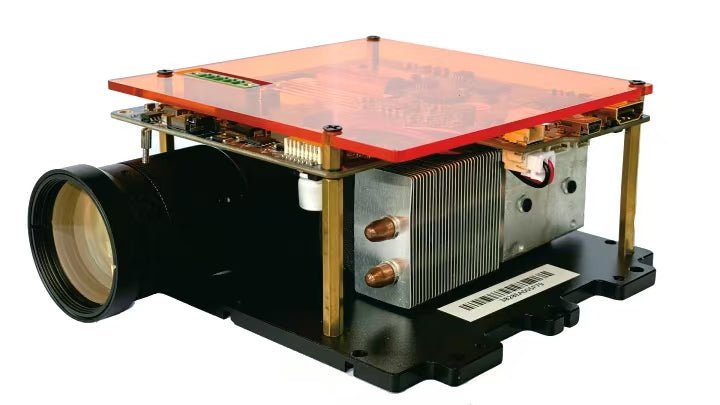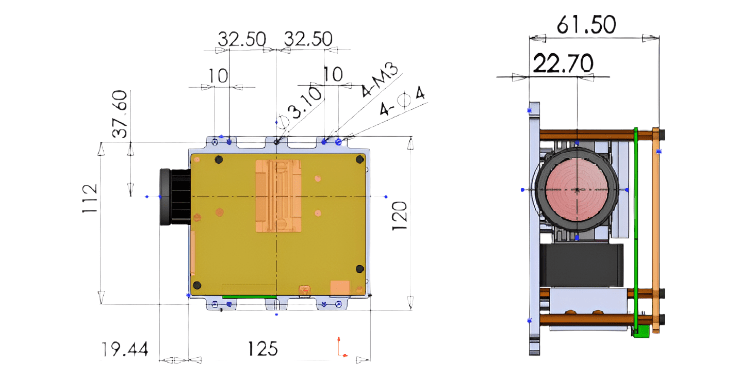

جهاز عرض DLP4710 عالي الدقة 1080 بكسل بتقنية الأشعة فوق البنفسجية للمسح الضوئي أو الطباعة ثلاثية الأبعاد
وصف:
يستخدم جهاز عرض الأشعة فوق البنفسجية للطباعة ثلاثية الأبعاد المتقدم DLP4710 أحدث مخطط DLP4710 DMD (1080P) مقاس 0.47 بوصة من TI مع درجة بكسل مجاورة تبلغ 5.4 ميكرومتر.
الميزات الرئيسية
دعم متعدد الأطوال الموجية
متوافق مع مصابيح LED 385/405/450 نانومتر لمعالجة البوليمر الضوئي المتنوع
عدسات الإسقاط القابلة للتبديل (تدعم تعديلات مسافة العمل من 150 إلى 2000 مم)
التحكم المتزامن
يخزن أنماط التدرج الرمادي مباشرةً مع وقت التعرض القابل للتكوين (1 مللي ثانية - 60 ثانية)
مزامنة مشغلات الإدخال/الإخراج للأجهزة الطرفية (الكاميرات/أجهزة الاستشعار)
التحكم في شدة إضاءة LED في الوقت الفعلي (0-100% PWM) + التبديل بين التشغيل والإيقاف
التطبيقات الصناعية
الطباعة ثلاثية الأبعاد عالية الدقة (دقة طبقة <50 ميكرومتر)
المسح الضوئي ثلاثي الأبعاد بالضوء المنظم (إعادة بناء السطح على مستوى الميكرون)
متوافق مع طابعات DLP ثلاثية الأبعاد وأنظمة القياس الصناعية
التحقق الفني
يحقق 98% من التوحيد البصري من خلال تصميم الإزاحة الصفرية المحورية
يحافظ على استقرار الكثافة بنسبة ±1% أثناء التشغيل المستمر لمدة 72 ساعة
يدعم التشغيل دون اتصال بالإنترنت مع تخزين الأنماط المضمنة
سمات:
عدسة اختيارية لحجم الصورة المختلفة
تحقيق دقة طباعة 35/50/75 ميكرومتر
متوافق مع مصادر ضوء LED 365-405 نانومتر مع أطوال موجية متعددة
تصميم مسار بصري محوري، وتوحيد عالي، وتشويه منخفض
عدسة بصرية زجاجية بالكامل، جسم معدني
حجم صغير، يدعم التطوير الثانوي للأجهزة والبرمجيات والبصريات
مجموعة أدوات تطوير البرامج (SDK) لأنظمة Widows/Linux/Ubuntu/RaspberryPi
المواصفات:

تعليمات الاستخدام :
يعتمد جهاز عرض الأشعة فوق البنفسجية تصميمًا سهل الاستخدام، مما يجعله سهل الاستخدام للغاية. ما عليك سوى توصيل منفذ HDMI بمنفذ HDMI في جهاز الإدخال لعرض محتوى الفيديو المُدخل. للحصول على إعدادات متقدمة، مثل ضبط سطوع مصابيح LED وغيرها من المعلمات، يمكنك توصيل منفذ USB بجهاز الكمبيوتر وضبطها بسهولة باستخدام البرنامج الذي توفره شركتنا. رابط تنزيل البرنامج هو: https://www.si-cube.com/html/support-list.html .

جهاز عرض DLP4710 عالي الدقة 1080 بكسل بتقنية الأشعة فوق البنفسجية للمسح الضوئي أو الطباعة ثلاثية الأبعاد
If you have any questions, you are always welcome to contact us. We'll get back to you as soon as possible, within 24 hours on weekdays.
-
Shipping Information
Use this text to answer questions in as much detail as possible for your customers.
-
Customer Support
Use this text to answer questions in as much detail as possible for your customers.
-
FAQ’s
Use this text to answer questions in as much detail as possible for your customers.
-
Contact Us
Use this text to answer questions in as much detail as possible for your customers.
FAQs
Please read our FAQs page to find out more.
What transportation method do you use?
All our products are shipped via international express services, such as DHL and FedEx,? completely free of charge
What is DLP 3D printing, and how does it work?
DLP 3D printing is a resin-based additive manufacturing technology that uses light to cure liquid photopolymer layer by layer. It involves projecting digital images onto a vat of liquid resin, where the exposed resin hardens to form each layer of the 3D object.
How does DLP 3D printing differ from other 3D printing technologies?
DLP 3D printing differs from other technologies such as FDM (Fused Deposition Modeling) in its use of light to cure resin, which allows for faster and more precise printing. It also typically offers higher resolution and smoother surface finishes.
Why are UV projectors critical in DLP 3D printing?
UV projectors are critical in DLP 3D printing because they emit the ultraviolet light that cures the resin. The quality, speed, and reliability of the printing process depend heavily on the performance of the UV projector.
What factors should be considered when selecting a UV projector for DLP 3D printing?
When selecting a UV projector, factors to consider include wavelength, resolution, LED lifespan, controller compatibility, and mechanical integration. The ideal projector should match the specific needs and requirements of the DLP 3D printing system.
What are the system requirements for DLP 3D printing?
System requirements for DLP 3D printing include a compatible UV projector, resin vat, build platform, and control system. Specific hardware specifications, such as resolution and interface compatibility, should also be considered.
How do I connect and configure a DLP 3D printing system?
Connecting and configuring a DLP 3D printing system typically involves connecting the UV projector to a PC via USB, launching the manufacturer's proprietary configuration software, and setting up the printer parameters, such as layer thickness and exposure time.
What is "pixelation" in DLP 3D printed models, and how can it be addressed?
Pixelation" refers to the appearance of tiny square or grid-like patterns on the surface of DLP 3D printed models. It can be addressed by increasing the resolution of the UV projector, adjusting the light curing parameters, or optimizing the print path.
What role do TIR prisms play in DLP 3D printing, and why are they important?
TIR (Total Internal Reflection) prisms play a critical role in DLP 3D printing by precisely redirecting light from the micro-mirror arrays to the projection optics. They maintain polarization and ensure that the light is evenly distributed across the resin vat, which is essential for high-quality printing.
What languages and currencies are supported on
The website supports multiple languages, including English, Simplified Chinese, Arabic, Korean, German, and Japanese. It also offers a variety of currency options, such as USD, EUR, AUD, and more, to cater to international visitors.
How can I stay updated with new collections and exclusive offers
To stay updated with new collections and exclusive offers, you can subscribe to the website's newsletter by providing your email address. This will allow you to receive notifications about the latest products, promotions, and news directly to your inbox.
